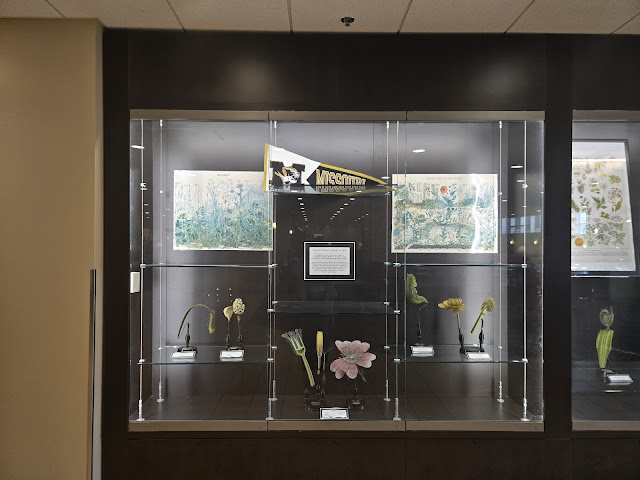Biological Narratives: Science, Art and Time is an exhibition we, MU Student Center, collaborate with Biological Science. One part of this exhibition celebrates the evolution of the Biological Sciences department at MIZZOU, showcasing artifacts that bridge the past and present of scientific discovery. The antique scales, stones, and a pharmacy bottle, still used in teaching today, remind us of the enduring role these tools play in understanding both the earth’s history and the art of science itself. Another part is Brendel Flower Models ca.1900, which showcases a collection of German botanical models, polychrome papier-mâché mounted on a turned boxwood ebonized stand with a paper maker's label.
 |
| Biological Narratives: Science, Art, and Time on the first floor of MU Student Center |
The history of the Biological Sciences at MIZZOU reflects over a century of dedication to scientific education and research. Before 1894, the program began with three core classes—Botany, Zoology, And Entomology. As the field of biology evolved, so did the program, expanding to include genetics, ecology, neurophysiology, and animal communication.
By 1976, under the leadership of influential figures like Lefevre, Stadler, and McClintock, the Division had become a multidisciplinary force in research, closely collaborating with the university's medicine, veterinary, and agriculture departments. Substantial support from organizations like NIH and NSF helped fuel groundbreaking projects, while the program's rapid undergraduate growth reflected a rising awareness of the importance of life sciences.
The Division's enduring commitment to excellence in both teaching and research has made it a nationally recognized program, continuously adapting and contributing to biological knowledge.
Brendel flower models ca. 1900, on the lower-level cases,
showcase a collection of German botanical models, polychrome papier-mâché mounted on turned boxwood ebonized stand with paper maker's label.
 |
| Brendel flower models ca. 1900 on the lower-level cases of MU Student Center |
In the late 19th century, Robert Brendel and his son Reinhold produced beautiful and accurate models of enlarged flowers at Breslau and Berlin. Usually, the models were made of papier mâché, but with other materials added to give detail and texture: wood, cotton, rattan, pulp cane, glass beads,
feathers and gelatine.
To fully appreciate the rich history and scientific evolution at MIZZOU, we invite students, faculty, and visitors to explore the "Biological Narratives: Science, Art, and Time" exhibition at the MU Student Center. Whether you're interested in the fascinating journey of the Biological Sciences department, intrigued by the intricate craftsmanship of the Brendel flower models, or simply curious about the tools that have shaped scientific discovery, this exhibition offers something for everyone.
Come take a closer look and discover how art and science beautifully intersect, telling stories of knowledge, innovation, and the natural world. Don't miss out—stop by the first-floor and lower-level cases to experience it for yourself!
In addition, if you are looking for a place to enjoy warm and fresh air amidst fascinating plants. Visit the Tucker Hall Greenhouse, founded in 1975 at the University of Missouri. Here, you'll discover a diverse collection of over 500 plant species, including highlights like the Araceae, Cactaceae, and Apocynaceae families. Explore our Desert Room, Cactus Garden, and Tropical Room with a serene pond.
The greenhouse also serves as a valuable teaching resource for students and faculty studying Plant Systematics and Botany. Open to the public during regular hours, we invite you to schedule a guided tour for a deeper look into our collections.
Hours: Monday – Friday: 8:30 AM – 4:30 PM
Closed on major holidays and weekends
Group tours by appointment only.
To schedule a tour, please contact Kate Chaumont.
Title: Biological Narratives: Science, Art, and Time
Collections from Biological Science
Curator: Hongjue (Dorothy) Dai
Date: 10/15/2024-12/15/2024
Location: First floor and lower level of the MU Student Center








Comments
Post a Comment